BerlinMOD Example#
This example uses synthetic trip data in Brussels generated by the MobilityDB-BerlinMOD generator to show some data manipulations available in PyMEOS. It is divided in 5 sections, each corresponding to one MEOS example:
This example uses the plotting capabilities of PyMEOS. To get the necessary dependencies for this example, you can run the following command:
pip install pymeos[plot, pandas] contextily distinctipy
from datetime import timedelta
from functools import partial
import contextily as cx
import distinctipy
import geopandas as gpd
import matplotlib.pyplot as plt
import pandas as pd
import shapely.geometry as shp
from pymeos import *
from pymeos.plotters import (
TemporalPointSequenceSetPlotter,
TemporalPointSequencePlotter,
)
from shapely import wkb
pymeos_initialize()
In every following section we use the data from the BerlinMOD Generator, so we will go ahead and read it.
trips = pd.read_csv(
"./data/trips.csv",
converters={
"trip": TGeomPointSeq,
},
)
trips.head()
| vehicle | day | seq | trip | |
|---|---|---|---|---|
| 0 | 1 | 2020-06-01 | 1 | [POINT(496253.84080706234 6601691.244869352)@2... |
| 1 | 1 | 2020-06-01 | 2 | [POINT(481241.17182724166 6588272.126511315)@2... |
| 2 | 1 | 2020-06-02 | 1 | [POINT(496253.84080706234 6601691.244869352)@2... |
| 3 | 1 | 2020-06-02 | 2 | [POINT(481241.17182724166 6588272.126511315)@2... |
| 4 | 1 | 2020-06-03 | 1 | [POINT(496253.84080706234 6601691.244869352)@2... |
Disassembling Trips (MEOS Example)#
In this section, we disassemble the trips into individual observations and write them in a CSV file ordered by timestamp.
First, we’ll obtain every timestamp and value from the trajectory object (TGeogPointSeq) using the timestamps and values functions respectively
records = trips.drop("trip", axis=1).copy()
records["geom"] = trips["trip"].apply(lambda tr: tr.values())
records["t"] = trips["trip"].apply(lambda tr: tr.timestamps())
records.head()
| vehicle | day | seq | geom | t | |
|---|---|---|---|---|---|
| 0 | 1 | 2020-06-01 | 1 | [POINT (496253.84080706234 6601691.244869352),... | [2020-06-01 11:48:50.886000+02:00, 2020-06-01 ... |
| 1 | 1 | 2020-06-01 | 2 | [POINT (481241.17182724166 6588272.126511315),... | [2020-06-01 18:00:27.208000+02:00, 2020-06-01 ... |
| 2 | 1 | 2020-06-02 | 1 | [POINT (496253.84080706234 6601691.244869352),... | [2020-06-02 11:31:07.888000+02:00, 2020-06-02 ... |
| 3 | 1 | 2020-06-02 | 2 | [POINT (481241.17182724166 6588272.126511315),... | [2020-06-02 18:47:26.738000+02:00, 2020-06-02 ... |
| 4 | 1 | 2020-06-03 | 1 | [POINT (496253.84080706234 6601691.244869352),... | [2020-06-03 11:30:29.334000+02:00, 2020-06-03 ... |
Now we “explode” the t and geom columns to get a row per record. Then, we sort the records by timestamp.
records = records.explode(["geom", "t"], ignore_index=True)
records = records.sort_values("t")
records.head()
| vehicle | day | seq | geom | t | |
|---|---|---|---|---|---|
| 110254 | 8 | 2020-06-01 | 1 | POINT (493442.7231019071 6595901.46838472) | 2020-06-01 10:22:51.025000+02:00 |
| 110255 | 8 | 2020-06-01 | 1 | POINT (493443.8028284878 6595906.350412016) | 2020-06-01 10:22:52.525000+02:00 |
| 110256 | 8 | 2020-06-01 | 1 | POINT (493444.404026218 6595909.068751807) | 2020-06-01 10:22:54.574117+02:00 |
| 110257 | 8 | 2020-06-01 | 1 | POINT (493441.7878750556 6595913.329708636) | 2020-06-01 10:22:55.639765+02:00 |
| 110258 | 8 | 2020-06-01 | 1 | POINT (493428.7071192439 6595934.634492779) | 2020-06-01 10:23:00.139765+02:00 |
Finally, we will write it in a CSV file, encoding first the geometries as HexWKB
records["geom"] = records["geom"].apply(partial(wkb.dumps, hex=True))
records.head()
| vehicle | day | seq | geom | t | |
|---|---|---|---|---|---|
| 110254 | 8 | 2020-06-01 | 1 | 01010000008BD374E40A1E1E41E803FA5D4F295941 | 2020-06-01 10:22:51.025000+02:00 |
| 110255 | 8 | 2020-06-01 | 1 | 0101000000CEAB18360F1E1E4185266D9650295941 | 2020-06-01 10:22:52.525000+02:00 |
| 110256 | 8 | 2020-06-01 | 1 | 0101000000840CB99D111E1E41FB6D664451295941 | 2020-06-01 10:22:54.574117+02:00 |
| 110257 | 8 | 2020-06-01 | 1 | 0101000000F5B7C826071E1E4140F2195552295941 | 2020-06-01 10:22:55.639765+02:00 |
| 110258 | 8 | 2020-06-01 | 1 | 01010000002C1117D4D21D1E419A879BA857295941 | 2020-06-01 10:23:00.139765+02:00 |
records.to_csv("./data/trip_instants.csv", index=False)
Clipping Trips to Geometries (MEOS Example)#
In this section, we compute the distance traversed by the trips in the 19 Brussels municipalities (communes in French)
First, we will read the files containing the information about the Brussels region and its municipalities and take a look at their shape
brussels = pd.read_csv(
"./data/brussels_region.csv", converters={"geom": partial(wkb.loads, hex=True)}
)
brussels = gpd.GeoDataFrame(brussels, geometry="geom")
brussels_geom = brussels["geom"][0]
brussels
| name | geom | |
|---|---|---|
| 0 | Région de Bruxelles-Capitale - Brussels Hoofds... | POLYGON ((472413.848 6589441.686, 472482.354 6... |
communes = pd.read_csv(
"./data/communes.csv", converters={"geom": partial(wkb.loads, hex=True)}
)
communes["color"] = [
"#00ff00",
"#ff00ff",
"#007fff",
"#ff7f00",
"#7fbf7f",
"#47139e",
"#ad0414",
"#d981f9",
"#138014",
"#f4fc2c",
"#00ffff",
"#00ff7f",
"#c04d7c",
"#85eaf3",
"#85d601",
"#fca880",
"#0000ff",
"#019d92",
"#907817",
]
communes = gpd.GeoDataFrame(communes, geometry="geom")
communes
| id | name | population | geom | color | |
|---|---|---|---|---|---|
| 0 | 1 | Anderlecht | 118241 | POLYGON ((476959.746 6593981.357, 476965.401 6... | #00ff00 |
| 1 | 2 | Auderghem - Oudergem | 33313 | POLYGON ((497620.844 6584185.646, 497856.652 6... | #ff00ff |
| 2 | 3 | Berchem-Sainte-Agathe - Sint-Agatha-Berchem | 24701 | POLYGON ((477788.720 6599192.996, 477782.631 6... | #007fff |
| 3 | 4 | Etterbeek | 176545 | POLYGON ((489804.602 6593678.230, 489685.067 6... | #ff7f00 |
| 4 | 5 | Evere | 47414 | POLYGON ((492771.667 6597070.173, 492633.519 6... | #7fbf7f |
| 5 | 6 | Forest - Vorst | 40394 | POLYGON ((479909.268 6585570.952, 479881.003 6... | #47139e |
| 6 | 7 | Ganshoren | 55746 | POLYGON ((478477.209 6600450.089, 478499.863 6... | #ad0414 |
| 7 | 8 | Ixelles - Elsene | 24596 | MULTIPOLYGON (((487496.626 6592340.790, 487544... | #d981f9 |
| 8 | 9 | Jette | 86244 | POLYGON ((481479.217 6597749.534, 481526.350 6... | #138014 |
| 9 | 10 | Koekelberg | 51933 | POLYGON ((480236.024 6597825.520, 480178.160 6... | #f4fc2c |
| 10 | 11 | Molenbeek-Saint-Jean - Sint-Jans-Molenbeek | 21609 | POLYGON ((477542.960 6595837.350, 477533.621 6... | #00ffff |
| 11 | 12 | Saint-Gilles - Sint-Gillis | 96629 | POLYGON ((483153.140 6593066.827, 483122.204 6... | #00ff7f |
| 12 | 13 | Saint-Josse-ten-Noode - Sint-Joost-ten-Node | 50471 | POLYGON ((485033.738 6596581.156, 484882.700 6... | #c04d7c |
| 13 | 14 | Schaerbeek - Schaarbeek | 27115 | POLYGON ((488501.707 6600305.815, 488394.028 6... | #85eaf3 |
| 14 | 15 | Uccle - Ukkel | 133042 | POLYGON ((486268.683 6588562.809, 486253.744 6... | #85d601 |
| 15 | 16 | Ville de Bruxelles - Stad Brussel | 82307 | POLYGON ((483153.140 6593066.827, 483186.758 6... | #fca880 |
| 16 | 17 | Watermael-Boitsfort - Watermaal-Bosvoorde | 24871 | POLYGON ((491240.935 6581131.551, 491340.822 6... | #0000ff |
| 17 | 18 | Woluwe-Saint-Lambert - Sint-Lambrechts-Woluwe | 55216 | POLYGON ((496682.744 6594589.884, 496653.033 6... | #019d92 |
| 18 | 19 | Woluwe-Saint-Pierre - Sint-Pieters-Woluwe | 41217 | POLYGON ((496135.453 6589271.827, 496258.928 6... | #907817 |
_, axes = plt.subplots(1, 2, figsize=(20, 10))
communes.plot(color=communes["color"], ax=axes[0])
communes.exterior.plot(ax=axes[0])
communes.plot(color=communes["color"], ax=axes[1], alpha=0.4)
communes.exterior.plot(ax=axes[1])
cx.add_basemap(axes[1])
_ = plt.suptitle("Brussels Municipalities", size=25, y=0.92)
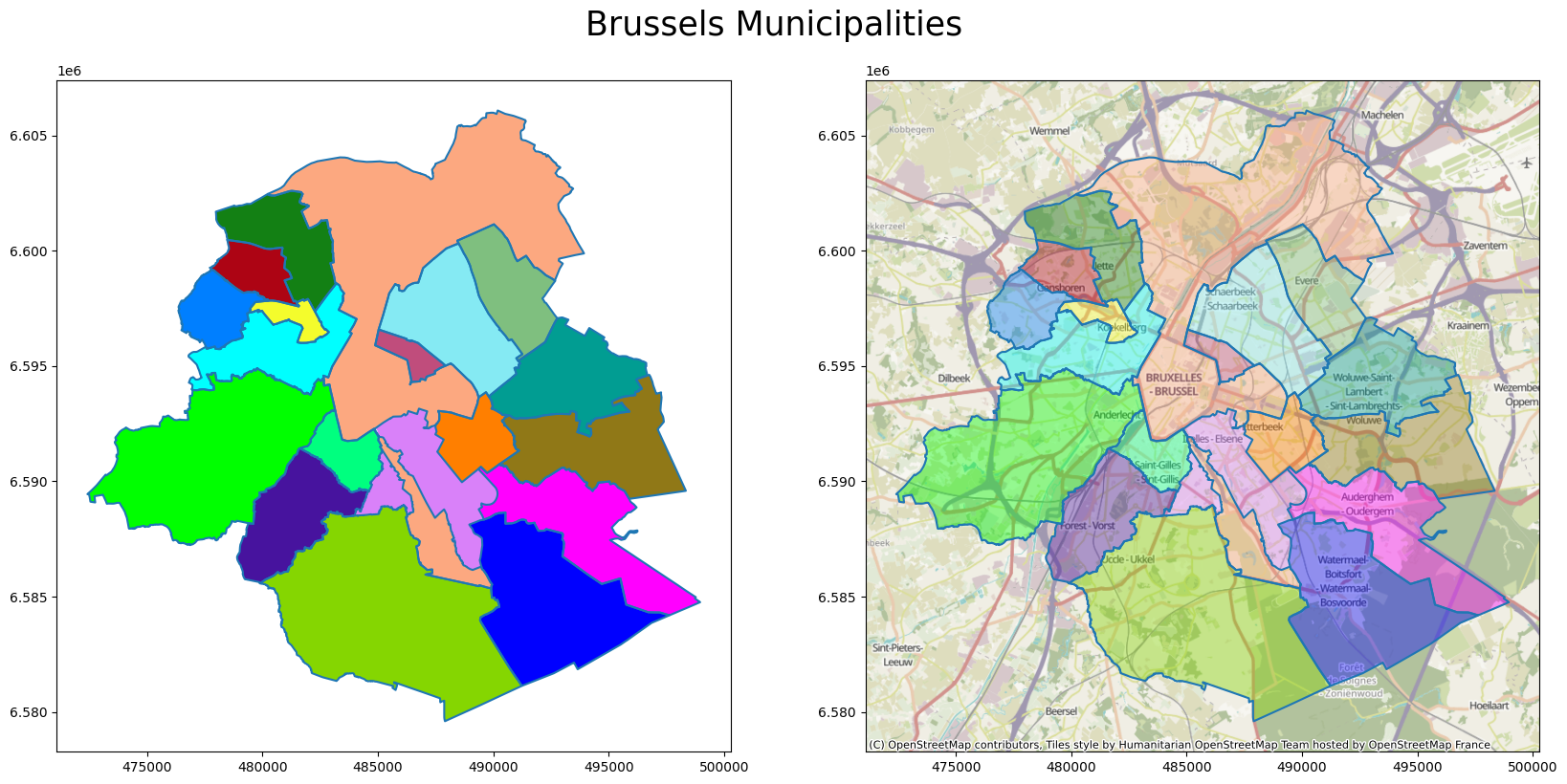
Now, let’s take a look at the BerlinMOD trajectories plotted over Brussels
_, axes = plt.subplots(1, 2, figsize=(20, 10))
communes.plot(color=communes["color"], ax=axes[0], alpha=0.4)
TemporalPointSequencePlotter.plot_sequences_xy(
trips["trip"], axes=axes[0], show_markers=False, show_grid=False
)
communes.plot(color=communes["color"], ax=axes[1], alpha=0.1)
communes.exterior.plot(ax=axes[1])
TemporalPointSequencePlotter.plot_sequences_xy(
trips["trip"], axes=axes[1], color="black", show_markers=False, show_grid=False
)
cx.add_basemap(axes[1])
_ = plt.suptitle("BerlinMod Trajectories", size=25, y=0.92)
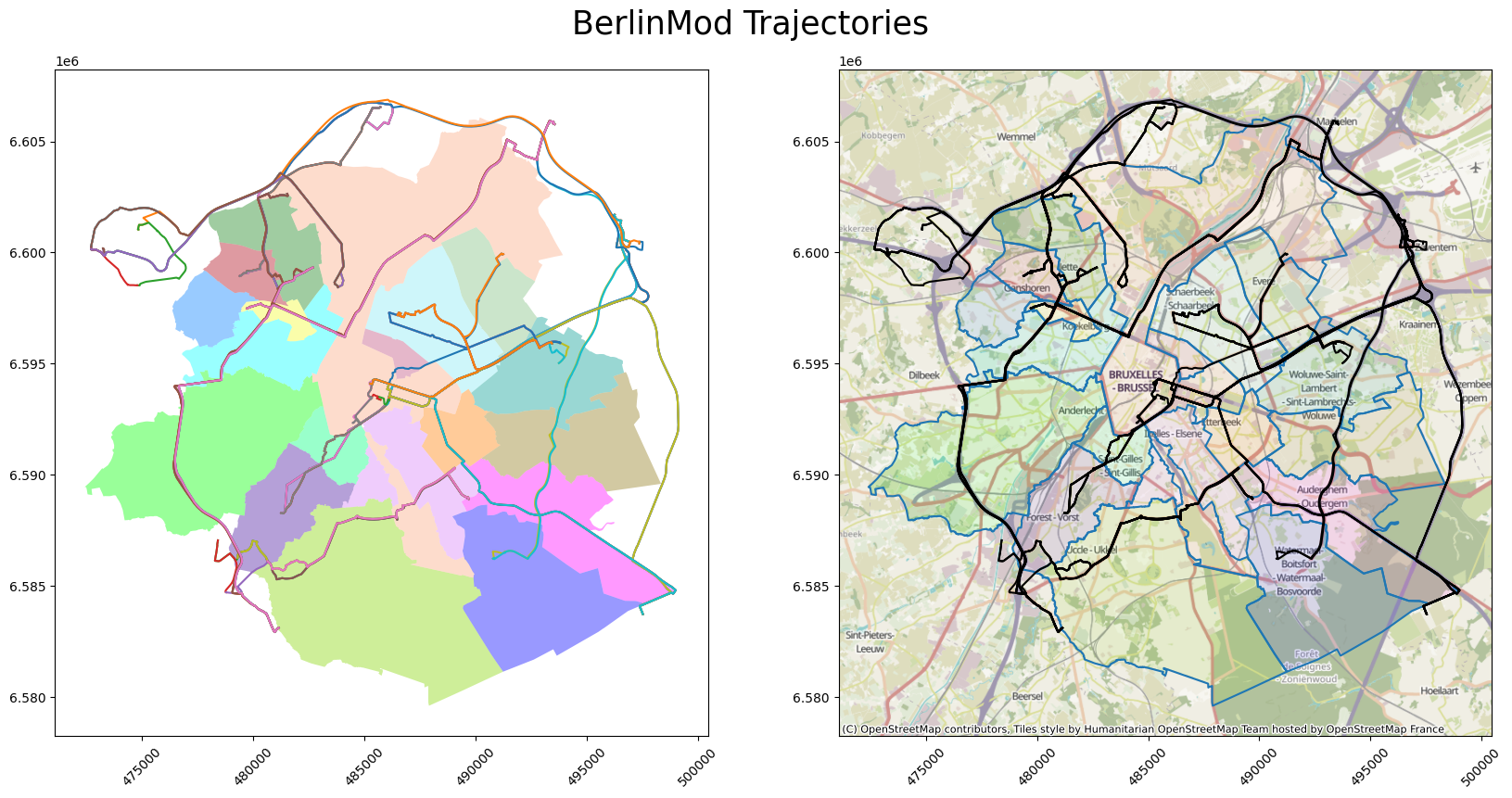
First, let’s split the trajectories into sections inside and outside of Brussels
brussels_inout_trajectories = trips.copy()
brussels_inout_trajectories["inside"] = brussels_inout_trajectories["trip"].apply(
lambda tr: tr.at(brussels_geom)
)
brussels_inout_trajectories["outside"] = brussels_inout_trajectories["trip"].apply(
lambda tr: tr.minus(brussels_geom)
)
brussels_inout_trajectories.head()
| vehicle | day | seq | trip | inside | outside | |
|---|---|---|---|---|---|---|
| 0 | 1 | 2020-06-01 | 1 | [POINT(496253.84080706234 6601691.244869352)@2... | {[POINT(493452.04564533016 6596592.507628961)@... | {[POINT(496253.84080706234 6601691.244869352)@... |
| 1 | 1 | 2020-06-01 | 2 | [POINT(481241.17182724166 6588272.126511315)@2... | {[POINT(481241.17182724166 6588272.126511315)@... | {(POINT(493488.118266309 6596572.0201423885)@2... |
| 2 | 1 | 2020-06-02 | 1 | [POINT(496253.84080706234 6601691.244869352)@2... | {[POINT(493452.04567213746 6596592.507642428)@... | {[POINT(496253.84080706234 6601691.244869352)@... |
| 3 | 1 | 2020-06-02 | 2 | [POINT(481241.17182724166 6588272.126511315)@2... | {[POINT(481241.17182724166 6588272.126511315)@... | {(POINT(493488.118266309 6596572.0201423885)@2... |
| 4 | 1 | 2020-06-03 | 1 | [POINT(496253.84080706234 6601691.244869352)@2... | {[POINT(493452.04567213746 6596592.507642428)@... | {[POINT(496253.84080706234 6601691.244869352)@... |
Let’s see this split in a plot
_, axes = plt.subplots(1, 2, figsize=(20, 10))
axes[0].set_title("Inside Brussels")
brussels.plot(ax=axes[0], alpha=0.4)
for traj in brussels_inout_trajectories["inside"].dropna():
if isinstance(traj, TGeomPointSeq):
TemporalPointSequencePlotter.plot_xy(
traj, axes=axes[0], show_markers=False, show_grid=False
)
else:
TemporalPointSequenceSetPlotter.plot_xy(
traj, axes=axes[0], show_markers=False, show_grid=False
)
axes[1].set_title("Outside Brussels")
brussels.plot(ax=axes[1], alpha=0.4)
for traj in brussels_inout_trajectories["outside"].dropna():
if isinstance(traj, TGeomPointSeq):
TemporalPointSequencePlotter.plot_xy(
traj, axes=axes[1], show_markers=False, show_grid=False
)
else:
TemporalPointSequenceSetPlotter.plot_xy(
traj, axes=axes[1], show_markers=False, show_grid=False
)
axes[0].set_xlim(
min(axes[0].get_xlim()[0], axes[1].get_xlim()[0]),
max(axes[0].get_xlim()[1], axes[1].get_xlim()[1]),
)
axes[0].set_ylim(
min(axes[0].get_ylim()[0], axes[1].get_ylim()[0]),
max(axes[0].get_ylim()[1], axes[1].get_ylim()[1]),
)
_ = plt.suptitle("BerlinMod Trajectories Inside/Outside Brussels", size=25)
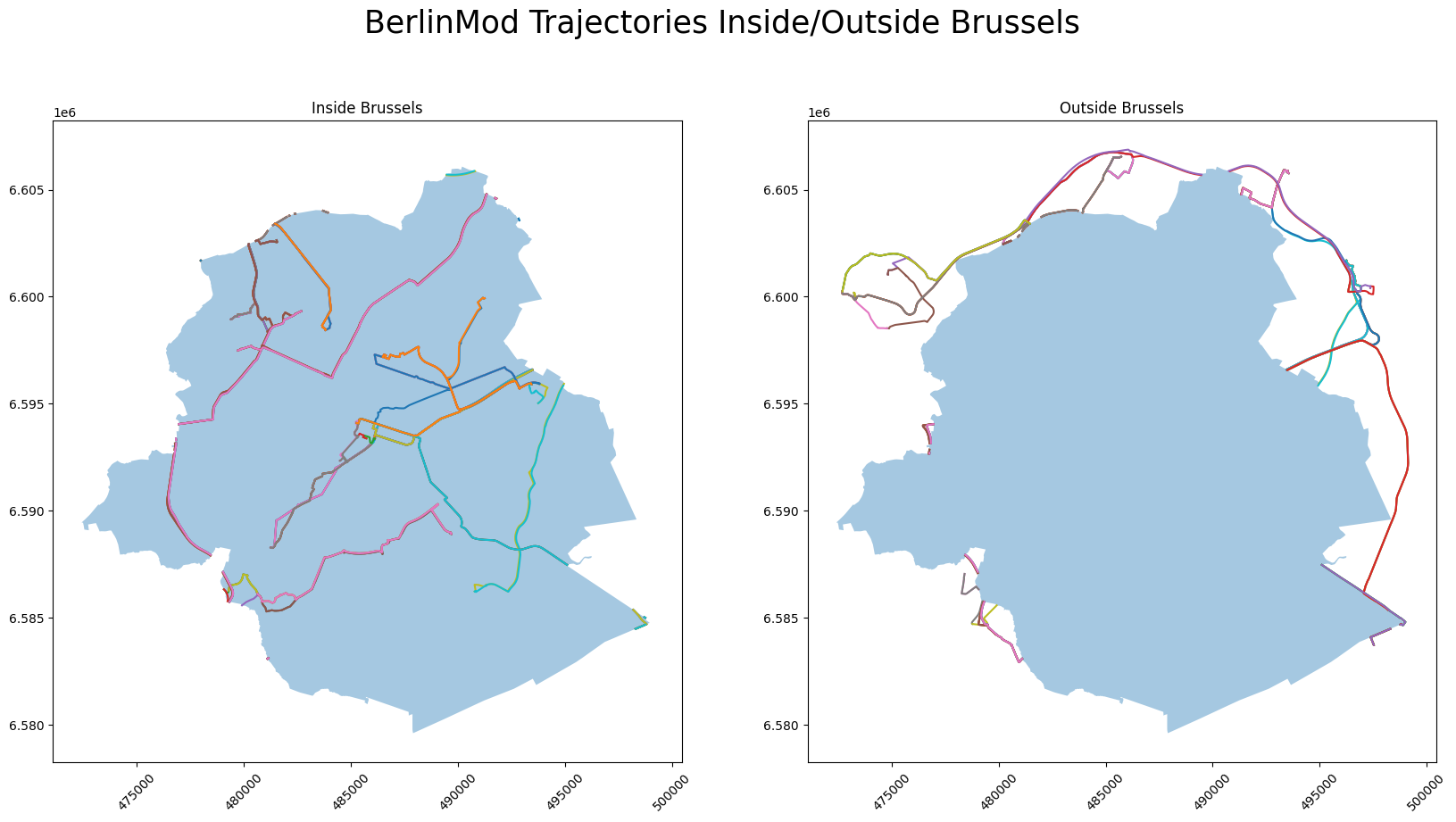
Now we will compute the trajectory and distance each trip traverses in each municipality
commune_trajectories = trips.copy()
for _, row in communes.iterrows():
commune_trajectories[f'{row["name"]}-trajectory'] = commune_trajectories[
"trip"
].apply(lambda tr: tr.at(row["geom"]))
commune_trajectories[f'{row["name"]}-distance'] = commune_trajectories[
f'{row["name"]}-trajectory'
].apply(lambda tr: tr.length() if tr else 0)
commune_trajectories.head()
| vehicle | day | seq | trip | Anderlecht-trajectory | Anderlecht-distance | Auderghem - Oudergem-trajectory | Auderghem - Oudergem-distance | Berchem-Sainte-Agathe - Sint-Agatha-Berchem-trajectory | Berchem-Sainte-Agathe - Sint-Agatha-Berchem-distance | ... | Uccle - Ukkel-trajectory | Uccle - Ukkel-distance | Ville de Bruxelles - Stad Brussel-trajectory | Ville de Bruxelles - Stad Brussel-distance | Watermael-Boitsfort - Watermaal-Bosvoorde-trajectory | Watermael-Boitsfort - Watermaal-Bosvoorde-distance | Woluwe-Saint-Lambert - Sint-Lambrechts-Woluwe-trajectory | Woluwe-Saint-Lambert - Sint-Lambrechts-Woluwe-distance | Woluwe-Saint-Pierre - Sint-Pieters-Woluwe-trajectory | Woluwe-Saint-Pierre - Sint-Pieters-Woluwe-distance | |
|---|---|---|---|---|---|---|---|---|---|---|---|---|---|---|---|---|---|---|---|---|---|
| 0 | 1 | 2020-06-01 | 1 | [POINT(496253.84080706234 6601691.244869352)@2... | None | 0.0 | None | 0.0 | None | 0 | ... | None | 0.0 | {[POINT(489089.14461377583 6594225.227862967)@... | 6238.532446 | None | 0.0 | {[POINT(493452.04564533016 6596592.507628961)@... | 2743.319101 | None | 0.0 |
| 1 | 1 | 2020-06-01 | 2 | [POINT(481241.17182724166 6588272.126511315)@2... | None | 0.0 | None | 0.0 | None | 0 | ... | None | 0.0 | {[POINT(484373.02614611824 6591974.073148593)@... | 5890.625638 | None | 0.0 | {[POINT(491131.62956994347 6595158.952745219)@... | 2753.083663 | None | 0.0 |
| 2 | 1 | 2020-06-02 | 1 | [POINT(496253.84080706234 6601691.244869352)@2... | None | 0.0 | None | 0.0 | None | 0 | ... | None | 0.0 | {[POINT(489089.14461377583 6594225.227862967)@... | 6238.532450 | None | 0.0 | {[POINT(493452.04567213746 6596592.507642428)@... | 2743.319131 | None | 0.0 |
| 3 | 1 | 2020-06-02 | 2 | [POINT(481241.17182724166 6588272.126511315)@2... | None | 0.0 | None | 0.0 | None | 0 | ... | None | 0.0 | {[POINT(484373.02614611824 6591974.073148593)@... | 5890.625638 | None | 0.0 | {[POINT(491131.62956994347 6595158.952745219)@... | 2753.083663 | None | 0.0 |
| 4 | 1 | 2020-06-03 | 1 | [POINT(496253.84080706234 6601691.244869352)@2... | None | 0.0 | None | 0.0 | None | 0 | ... | None | 0.0 | {[POINT(489089.14461377583 6594225.227862967)@... | 6238.532450 | None | 0.0 | {[POINT(493452.04567213746 6596592.507642428)@... | 2743.319131 | None | 0.0 |
5 rows × 42 columns
distances = commune_trajectories[
["vehicle", "day", "seq", *(f"{commune}-distance" for commune in communes["name"])]
]
distances.head()
| vehicle | day | seq | Anderlecht-distance | Auderghem - Oudergem-distance | Berchem-Sainte-Agathe - Sint-Agatha-Berchem-distance | Etterbeek-distance | Evere-distance | Forest - Vorst-distance | Ganshoren-distance | ... | Koekelberg-distance | Molenbeek-Saint-Jean - Sint-Jans-Molenbeek-distance | Saint-Gilles - Sint-Gillis-distance | Saint-Josse-ten-Noode - Sint-Joost-ten-Node-distance | Schaerbeek - Schaarbeek-distance | Uccle - Ukkel-distance | Ville de Bruxelles - Stad Brussel-distance | Watermael-Boitsfort - Watermaal-Bosvoorde-distance | Woluwe-Saint-Lambert - Sint-Lambrechts-Woluwe-distance | Woluwe-Saint-Pierre - Sint-Pieters-Woluwe-distance | |
|---|---|---|---|---|---|---|---|---|---|---|---|---|---|---|---|---|---|---|---|---|---|
| 0 | 1 | 2020-06-01 | 1 | 0.0 | 0.0 | 0 | 0.0 | 0.0 | 3208.550776 | 0.0 | ... | 0.0 | 0.0 | 2082.592245 | 0.0 | 2241.087203 | 0.0 | 6238.532446 | 0.0 | 2743.319101 | 0.0 |
| 1 | 1 | 2020-06-01 | 2 | 0.0 | 0.0 | 0 | 0.0 | 0.0 | 3088.180926 | 0.0 | ... | 0.0 | 0.0 | 2438.565180 | 0.0 | 2254.134586 | 0.0 | 5890.625638 | 0.0 | 2753.083663 | 0.0 |
| 2 | 1 | 2020-06-02 | 1 | 0.0 | 0.0 | 0 | 0.0 | 0.0 | 3208.550776 | 0.0 | ... | 0.0 | 0.0 | 2082.592241 | 0.0 | 2241.087203 | 0.0 | 6238.532450 | 0.0 | 2743.319131 | 0.0 |
| 3 | 1 | 2020-06-02 | 2 | 0.0 | 0.0 | 0 | 0.0 | 0.0 | 3088.180930 | 0.0 | ... | 0.0 | 0.0 | 2438.565176 | 0.0 | 2254.134586 | 0.0 | 5890.625638 | 0.0 | 2753.083663 | 0.0 |
| 4 | 1 | 2020-06-03 | 1 | 0.0 | 0.0 | 0 | 0.0 | 0.0 | 3208.550776 | 0.0 | ... | 0.0 | 0.0 | 2082.592241 | 0.0 | 2241.087203 | 0.0 | 6238.532450 | 0.0 | 2743.319131 | 0.0 |
5 rows × 22 columns
Finally, let’s see the visualization of the trajectories split by commune
_, axes = plt.subplots(4, 5, figsize=(50, 40))
axes[0][0].set_title("Brussels Region")
communes.plot(color=communes["color"], ax=axes[0][0], alpha=0.4)
TemporalPointSequencePlotter.plot_sequences_xy(
trips["trip"], axes=axes[0][0], show_markers=False, show_grid=False
)
for i, commune in communes.iterrows():
ax = axes[(i + 1) // 5][(i + 1) % 5]
ax.set_title(commune["name"])
# Plot commune
if isinstance(commune["geom"], shp.Polygon):
ax.fill(*commune["geom"].exterior.xy, color=commune["color"], alpha=0.4)
else:
for g in commune["geom"].geoms:
ax.fill(*g.exterior.xy, color=commune["color"], alpha=0.4)
# Plot trajectories
trajs = commune_trajectories[f'{commune["name"]}-trajectory'].dropna()
for traj in trajs:
TemporalPointSequenceSetPlotter.plot_xy(
traj, axes=ax, show_markers=False, show_grid=False
)
_ = plt.suptitle("BerlinMod Trajectories by Commune", size=35, y=0.92)
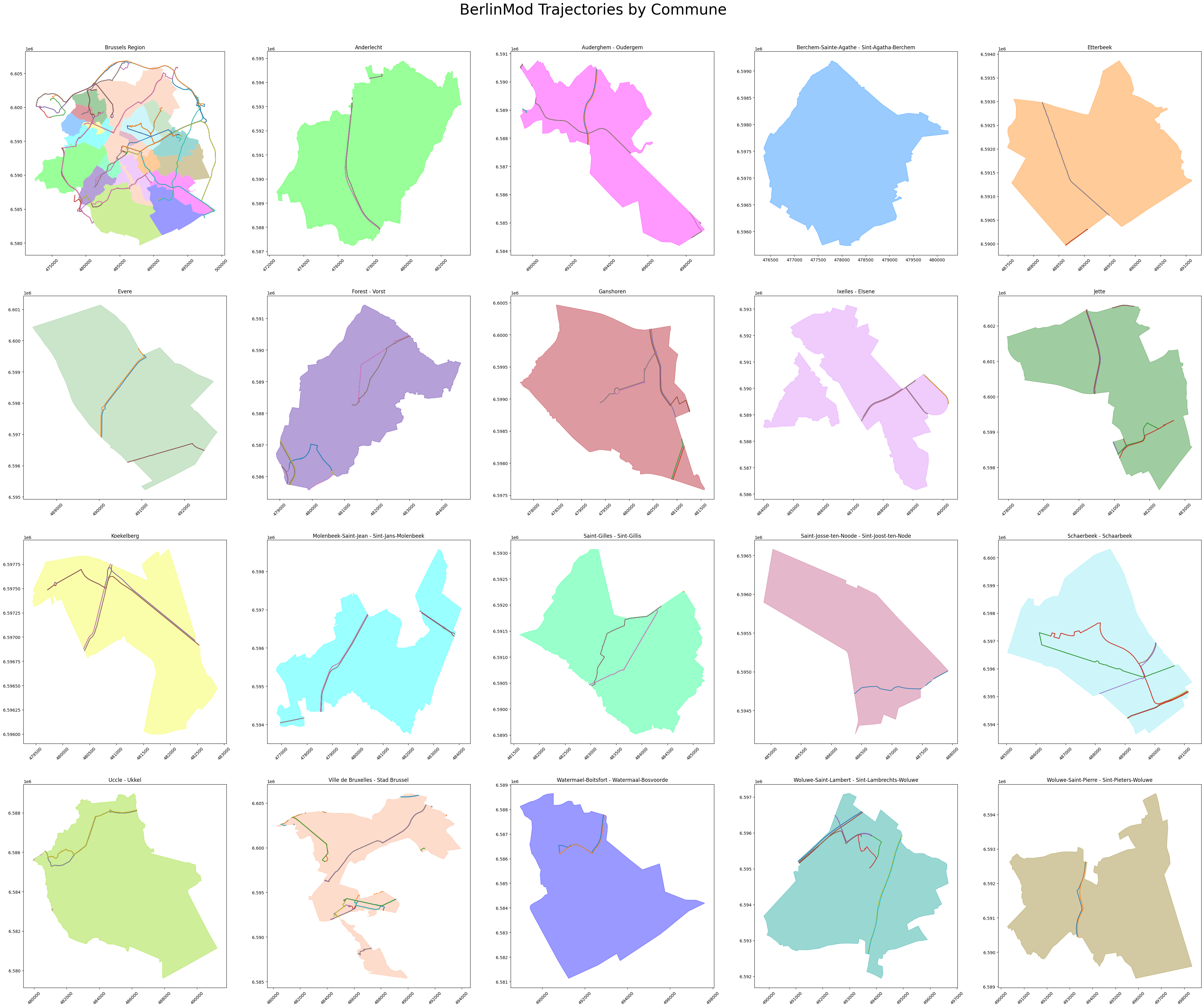
Simplifying Trips (MEOS Example)#
In this section, we will simplify the trajectories with two different methods, namely Douglas-Peucker (DP) and Syncronized Euclidean Distance (SED, aka Top-Down Time Ratio simplification), and compare the simplifications.
First, we’ll choose a distance tolerance to use in the simplification
tolerance = 20
Now, we’ll compute both simplifications with the simplify_douglas_peucker method (using the synchronized parameter to chose between DP or SED)
simplifications = trips.copy()
simplifications["dp"] = simplifications["trip"].apply(
lambda tr: tr.simplify_douglas_peucker(tolerance)
)
simplifications["sed"] = simplifications["trip"].apply(
lambda tr: tr.simplify_douglas_peucker(tolerance, synchronized=True)
)
simplifications.head()
| vehicle | day | seq | trip | dp | sed | |
|---|---|---|---|---|---|---|
| 0 | 1 | 2020-06-01 | 1 | [POINT(496253.84080706234 6601691.244869352)@2... | [POINT(496253.84080706234 6601691.244869352)@2... | [POINT(496253.84080706234 6601691.244869352)@2... |
| 1 | 1 | 2020-06-01 | 2 | [POINT(481241.17182724166 6588272.126511315)@2... | [POINT(481241.17182724166 6588272.126511315)@2... | [POINT(481241.17182724166 6588272.126511315)@2... |
| 2 | 1 | 2020-06-02 | 1 | [POINT(496253.84080706234 6601691.244869352)@2... | [POINT(496253.84080706234 6601691.244869352)@2... | [POINT(496253.84080706234 6601691.244869352)@2... |
| 3 | 1 | 2020-06-02 | 2 | [POINT(481241.17182724166 6588272.126511315)@2... | [POINT(481241.17182724166 6588272.126511315)@2... | [POINT(481241.17182724166 6588272.126511315)@2... |
| 4 | 1 | 2020-06-03 | 1 | [POINT(496253.84080706234 6601691.244869352)@2... | [POINT(496253.84080706234 6601691.244869352)@2... | [POINT(496253.84080706234 6601691.244869352)@2... |
_, axes = plt.subplots(1, 3, figsize=(30, 10))
for _, trip in simplifications.iterrows():
trip["trip"].plot(axes=axes[0])
trip["dp"].plot(axes=axes[1])
trip["sed"].plot(axes=axes[2])
axes[0].set_title("Original trajectories")
axes[1].set_title("Simplified trajectories (DP)")
axes[2].set_title("Simplified trajectories (SED)")
plt.show()
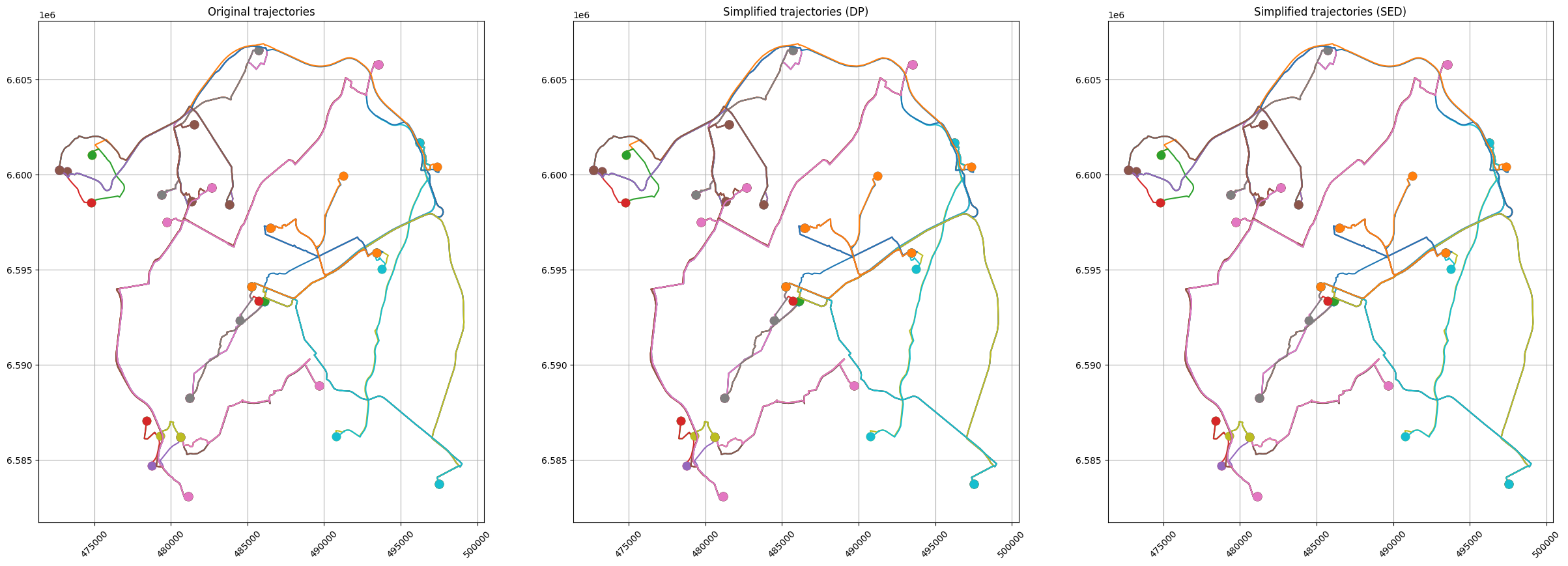
Let’s focus on only one trajectory to see the simplification more clearly
trip_example = simplifications.iloc[20]
fig, ax = plt.subplots(figsize=(16, 8))
trip_example["dp"].plot(label="Douglas-Peucker")
trip_example["sed"].plot(label="Syncronized Euclidean Distance")
trip_example["trip"].plot(label="Original trajectory")
plt.legend()
plt.savefig("./output.svg")
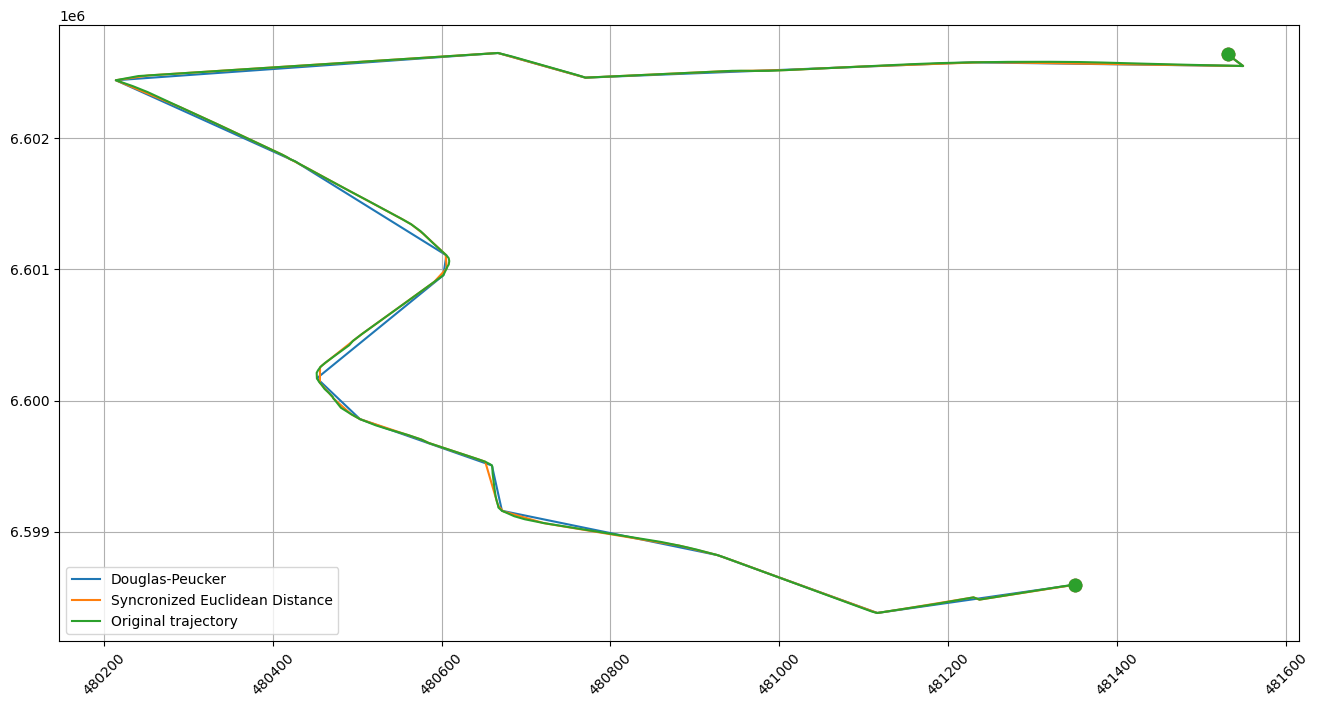
Now, let’s see the difference in points in each trajectory with their simplifications
distances = simplifications[["vehicle", "day", "seq"]].copy()
distances["trip"] = simplifications["trip"].apply(lambda tr: tr.num_instants())
distances["dp"] = simplifications["dp"].apply(lambda tr: tr.num_instants())
distances["sed"] = simplifications["sed"].apply(lambda tr: tr.num_instants())
distances["dp-delta"] = distances["trip"] - distances["dp"]
distances["sed-delta"] = distances["trip"] - distances["sed"]
distances["dp-%"] = distances["dp"] * 100 / distances["trip"]
distances["sed-%"] = distances["sed"] * 100 / distances["trip"]
distances.head()
| vehicle | day | seq | trip | dp | sed | dp-delta | sed-delta | dp-% | sed-% | |
|---|---|---|---|---|---|---|---|---|---|---|
| 0 | 1 | 2020-06-01 | 1 | 2103 | 48 | 212 | 2055 | 1891 | 2.282454 | 10.080837 |
| 1 | 1 | 2020-06-01 | 2 | 2326 | 65 | 232 | 2261 | 2094 | 2.794497 | 9.974205 |
| 2 | 1 | 2020-06-02 | 1 | 2110 | 48 | 207 | 2062 | 1903 | 2.274882 | 9.810427 |
| 3 | 1 | 2020-06-02 | 2 | 2308 | 65 | 235 | 2243 | 2073 | 2.816291 | 10.181976 |
| 4 | 1 | 2020-06-03 | 1 | 2071 | 48 | 190 | 2023 | 1881 | 2.317721 | 9.174312 |
We can see in the following table that the DP-simplified trips contain only a 3% of the original points in average, and that the SED-simplified ones around a 10%.
distances[["dp-delta", "dp-%", "sed-delta", "sed-%"]].describe()
| dp-delta | dp-% | sed-delta | sed-% | |
|---|---|---|---|---|
| count | 96.000000 | 96.000000 | 96.000000 | 96.000000 |
| mean | 1425.489583 | 2.686471 | 1315.750000 | 9.568915 |
| std | 718.930726 | 1.068704 | 649.342437 | 1.514393 |
| min | 98.000000 | 1.731844 | 91.000000 | 7.011070 |
| 25% | 923.500000 | 1.999928 | 875.250000 | 8.475305 |
| 50% | 1616.000000 | 2.367245 | 1471.500000 | 9.281897 |
| 75% | 2056.750000 | 2.859347 | 1894.000000 | 10.622931 |
| max | 3333.000000 | 7.547170 | 2990.000000 | 14.150943 |
Temporal Aggregation of Trips (MEOS Example)#
In this section we will aggregate the trips to calculate the extent (the spatiotemporal bounding box) and the temporal count (the evolution on time of the number of vehicles travelling). PyMEOS offers two APIs for aggregating: bulk and streaming.
Bulk aggregation#
If you have all the elements to aggregate in memory, you can use the bulk aggregation to perform it in a single call.
To do so, use the aggregate methods of the aggregator classes.
Now, let’s compute the extent and the temporal count using the TemporalPointExtentAggregator and TemporalPeriodCountAggregator respectively
extent_bulk = TemporalPointExtentAggregator.aggregate(trips["trip"])
tcount_bulk = TemporalPeriodCountAggregator.aggregate(trips["trip"])
_, axes = plt.subplots(1, 2, figsize=(20, 10))
extent_bulk.plot_xy(axes=axes[0], label="Spatial Extent")
for _, trip in trips.iterrows():
trip["trip"].plot(axes=axes[0], show_markers=False)
axes[0].set_title("Spatial Extent")
tcount_bulk.plot(axes=axes[1], label="Temporal Count", color="g")
extent_bulk.to_tstzspan().plot(axes=axes[1], label="Temporal Extent")
axes[1].set_title("Temporal Count + Temporal Extent")
plt.legend()
plt.show()
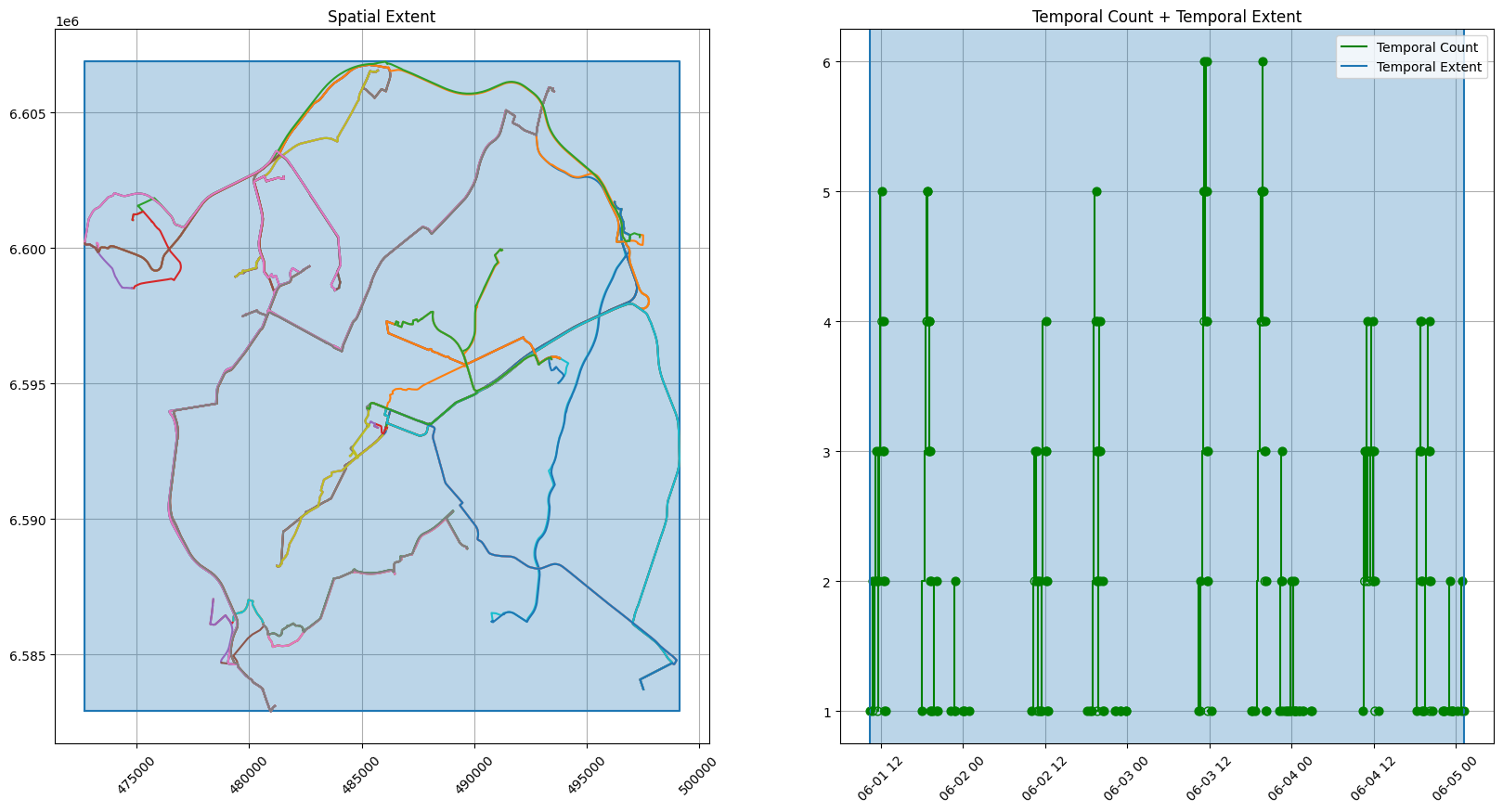
Let’s take the extent of only a few hours to see clearly the aggregations
day_trips = (
trips["trip"]
.apply(lambda tr: tr.at(TsTzSpan("[2020-06-01 08:00:00, 2020-06-01 12:00:00]")))
.dropna()
)
day_extent = TemporalPointExtentAggregator.aggregate(day_trips)
day_tcount = TemporalPeriodCountAggregator.aggregate(day_trips)
_, axes = plt.subplots(1, 2, figsize=(20, 10))
day_extent.plot_xy(axes=axes[0], label="Spatial Extent")
for trip in day_trips:
trip.plot(axes=axes[0], show_markers=False)
axes[0].set_title("Spatial Extent")
day_tcount.plot(axes=axes[1], label="Temporal Count", color="g")
day_extent.to_tstzspan().plot(axes=axes[1], label="Temporal Extent")
axes[1].set_title("Temporal Count + Temporal Extent")
plt.legend()
plt.show()
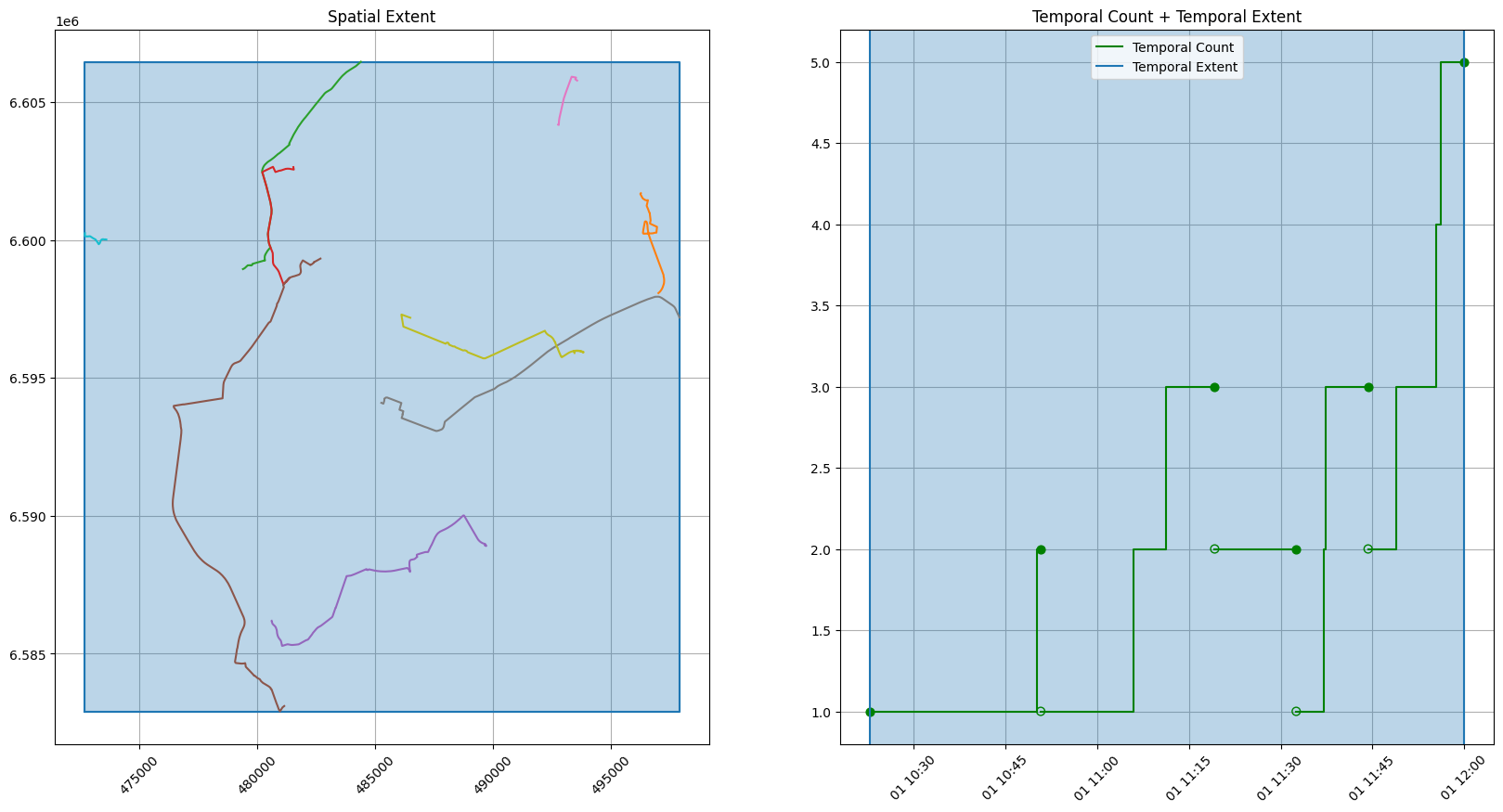
Streaming Aggregation#
There will be cases when you don’t have all the elements in memory at once, for example, maybe there are too many and memory is limited, or you are receiving them on real time, and you want to aggregate as they arrive.
In those cases, you can use the streaming aggregation to perform the aggregation in steps.
To do so, use the start_aggregation method of the aggregator class, and then use the object returned to perform the aggregation using the add and aggregation methods.
extent_aggregator = TemporalPointExtentAggregator.start_aggregation()
count_aggregator = TemporalPeriodCountAggregator.start_aggregation()
for trip in trips["trip"]:
extent_aggregator.add(trip)
count_aggregator.add(trip)
extent_stream = extent_aggregator.aggregation()
count_stream = count_aggregator.aggregation()
_, axes = plt.subplots(1, 2, figsize=(20, 10))
extent_stream.plot_xy(axes=axes[0], label="Spatial Extent")
for _, trip in trips.iterrows():
trip["trip"].plot(axes=axes[0], show_markers=False)
axes[0].set_title("Spatial Extent")
count_stream.plot(axes=axes[1], label="Temporal Count", color="g")
extent_stream.to_tstzspan().plot(axes=axes[1], label="Temporal Extent")
axes[1].set_title("Temporal Count + Temporal Extent")
plt.legend()
plt.show()

Note that you can keep aggregating after getting the result.
extent_aggregator = TemporalPointExtentAggregator.start_aggregation()
_, ax = plt.subplots(1, 1, figsize=(20, 10))
color = "black"
colors = []
for i, trip in enumerate(trips["trip"], 1):
extent_aggregator.add(trip)
if i % 10 == 0:
plot = extent_aggregator.aggregation().plot_xy(label=f"{i} trips")
color = plot[0][0].get_color()
colors += [color] * 10
extent_stream = extent_aggregator.aggregation()
extent_stream.plot_xy(label="Final extent")
for trip, color in zip(trips["trip"], colors):
trip.plot(show_markers=False, color=color)
plt.legend()
plt.show()
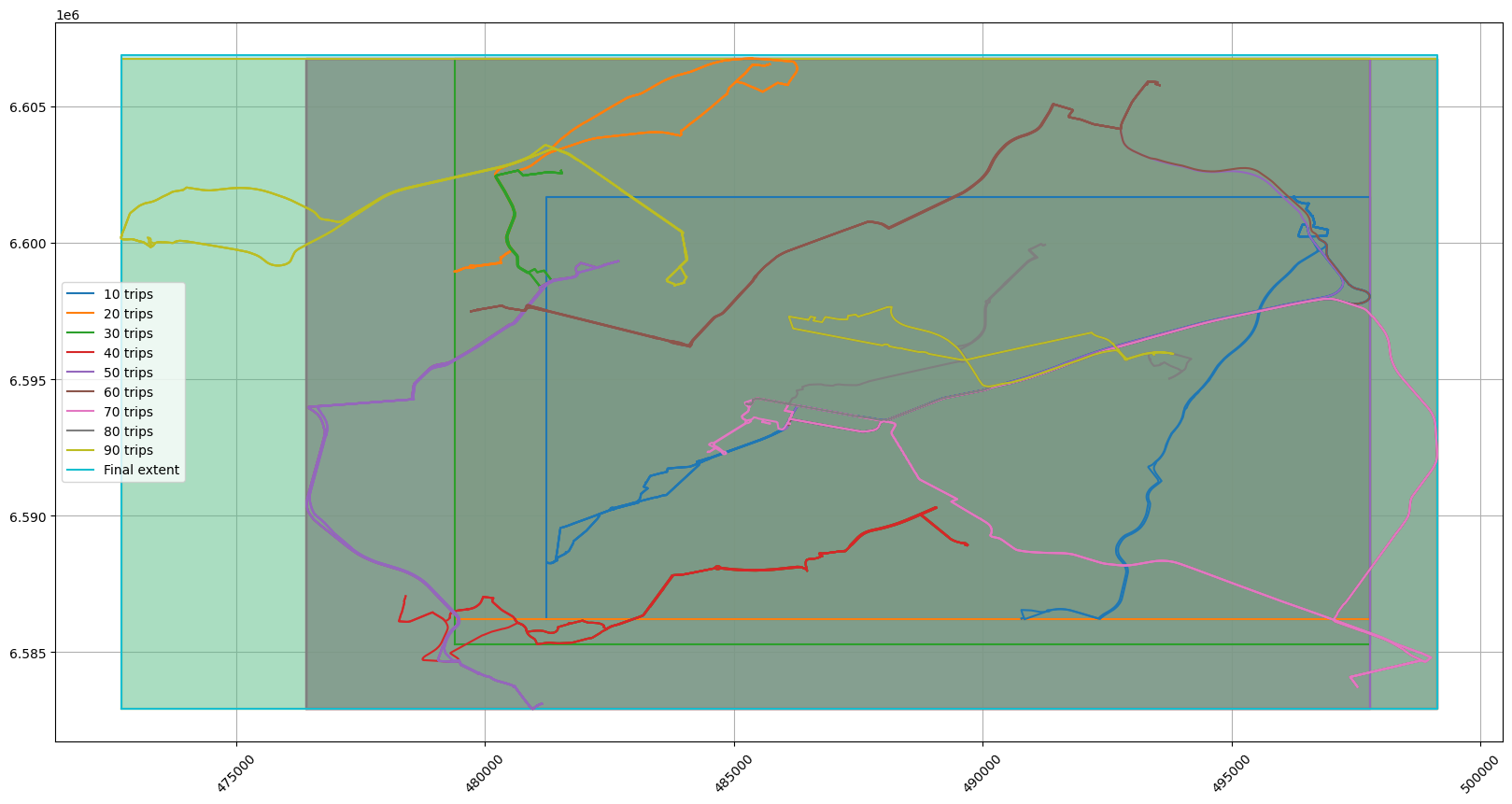
Tiling Trips (MEOS Example)#
In this section, the trajectories and the speed will be split into tiles, for which we will compute some aggregates.
First, let’s take a look at the tiled trajectories and speeds
tiled_trips = trips["trip"].apply(lambda tr: tr.tile(5e3, remove_empty=True))
speeds = trips["trip"].apply(lambda tr: tr.speed())
tiled_speeds = speeds.apply(
lambda sp: sp.value_time_split(10, "1 day", 0, "2020-06-01")
)
_, axes = plt.subplots(1, 2, figsize=(20, 10))
for tiled_trip in tiled_trips:
for traj in tiled_trip:
traj.plot(axes=axes[0], show_markers=False)
axes[0].set_title("Tiled Trajectories")
for tiled_speed in tiled_speeds:
for traj in tiled_speed:
traj.plot(axes=axes[1], show_markers=False)
axes[1].set_title("Tiled Speeds")
plt.show()
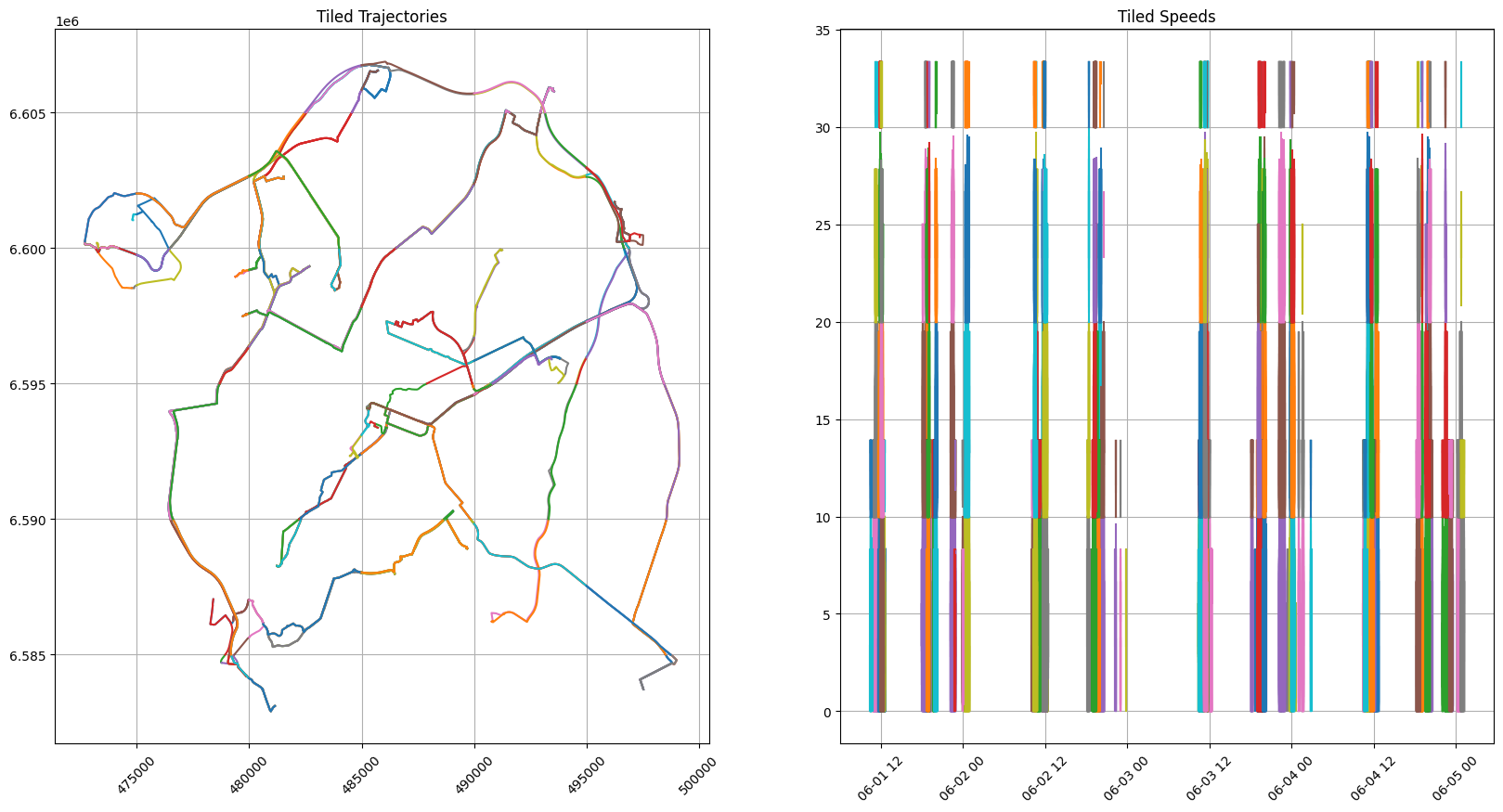
To see the tiles more clearly, let’s tile the extent of all the trips and speeds instead and compute the intersection of each trip with each tile (that is exactly what the tile function of TPointSeq is doing under the hood). This way, we can color them manually to see them clearly.
extent_tiles = extent_bulk.tile(5e3)
speed_extent = TemporalNumberExtentAggregator.aggregate(speeds)
speed_tiles = speed_extent.tile(10, "1 day", 0.0, "2020-06-01")
_, axes = plt.subplots(1, 2, figsize=(20, 10))
for tile, color in zip(extent_tiles, distinctipy.get_colors(len(extent_tiles))):
tile.plot_xy(axes=axes[0], color="black", draw_filling=False)
for trip in trips["trip"]:
trip_in_tile = trip.at(tile)
if trip_in_tile is not None:
trip_in_tile.plot(axes=axes[0], color=color, show_markers=False)
axes[0].set_title("Tiled Trajectories")
for tile, color in zip(speed_tiles, distinctipy.get_colors(len(speed_tiles))):
tile.plot(axes=axes[1], color="black", draw_filling=False)
for speed in speeds:
speed_in_tile = speed.at(tile)
if speed_in_tile is not None:
speed_in_tile.plot(axes=axes[1], color=color, show_markers=False)
axes[1].set_title("Tiled Speeds")
plt.show()
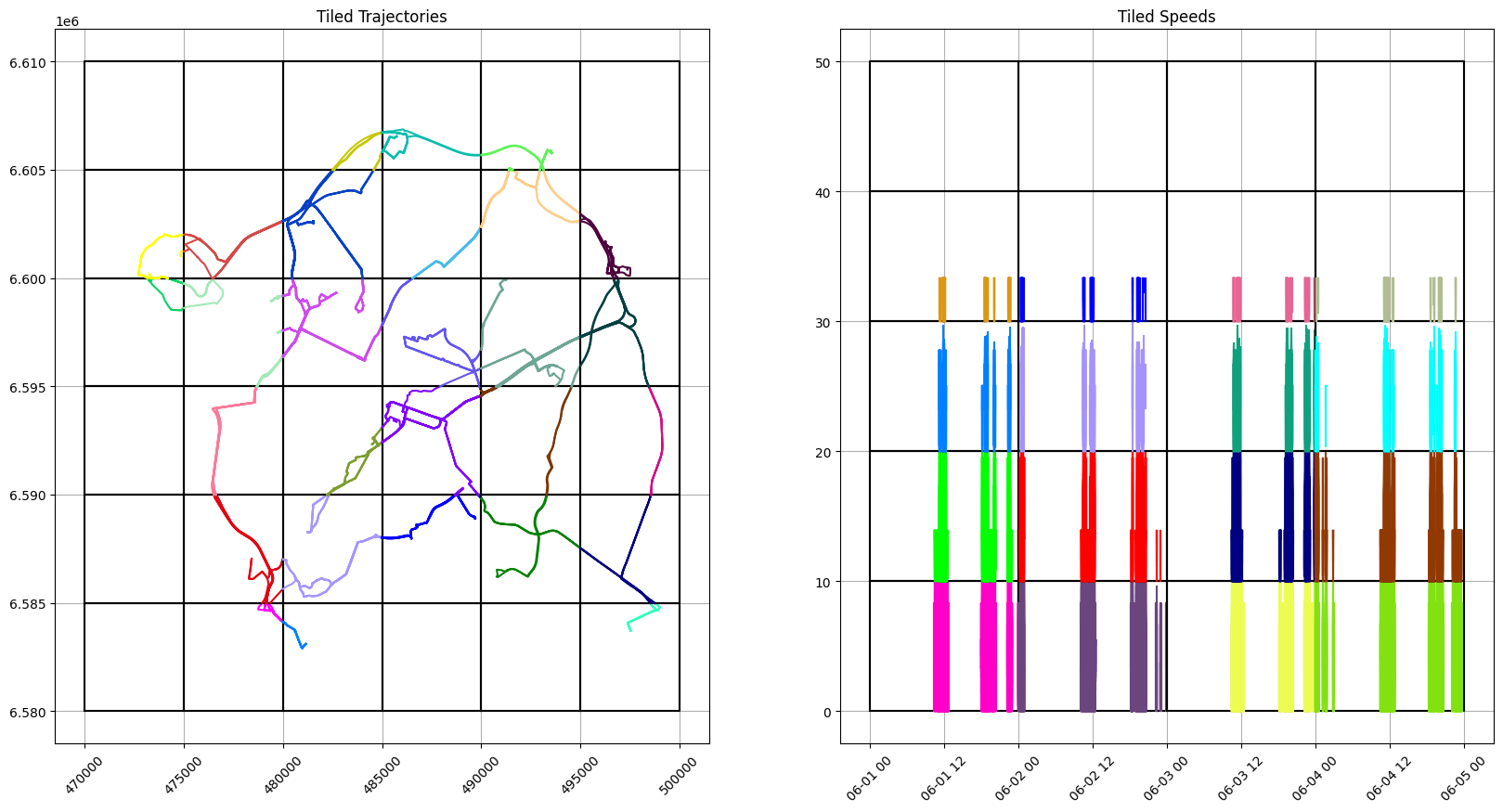
Finally, let’s aggregate the tiles to compute some metrics We will start by computing, for each spatial tile, the number of trajectories that enter it, and the total amount of time spent and the total distance traveled by them in the tile.
extent_tiles = extent_bulk.tile(5e3)
data = []
for tile in extent_tiles:
intersections = trips["trip"].apply(lambda tr: tr.at(tile)).dropna()
if len(intersections) == 0:
continue
count = len(intersections)
duration = sum([i.duration() for i in intersections], timedelta())
distance = sum([i.length() for i in intersections]) / 1000
data.append([tile, count, duration, distance])
spatial_aggregates = pd.DataFrame(
data, columns=["tile", "count", "duration", "distance"]
)
spatial_aggregates
| tile | count | duration | distance | |
|---|---|---|---|---|
| 0 | SRID=3857;STBOX X((475000,6580000),(480000,658... | 10 | 0 days 00:21:57.271928 | 12.715462 |
| 1 | SRID=3857;STBOX X((480000,6580000),(485000,658... | 8 | 0 days 00:37:50.260034 | 15.250435 |
| 2 | SRID=3857;STBOX X((495000,6580000),(500000,658... | 8 | 0 days 00:56:22.219006 | 19.807692 |
| 3 | SRID=3857;STBOX X((475000,6585000),(480000,659... | 13 | 0 days 01:42:26.592035 | 59.420951 |
| 4 | SRID=3857;STBOX X((480000,6585000),(485000,659... | 20 | 0 days 03:34:19.201837 | 73.582531 |
| 5 | SRID=3857;STBOX X((485000,6585000),(490000,659... | 12 | 0 days 02:07:10.468161 | 52.101740 |
| 6 | SRID=3857;STBOX X((490000,6585000),(495000,659... | 6 | 0 days 01:22:33.732748 | 36.422087 |
| 7 | SRID=3857;STBOX X((495000,6585000),(500000,659... | 8 | 0 days 00:47:50.956624 | 42.149632 |
| 8 | SRID=3857;STBOX X((475000,6590000),(480000,659... | 8 | 0 days 01:21:45.559201 | 54.962866 |
| 9 | SRID=3857;STBOX X((480000,6590000),(485000,659... | 10 | 0 days 01:39:18.880626 | 35.092058 |
| 10 | SRID=3857;STBOX X((485000,6590000),(490000,659... | 37 | 0 days 04:43:56.029545 | 135.629127 |
| 11 | SRID=3857;STBOX X((490000,6590000),(495000,659... | 21 | 0 days 01:08:30.026607 | 27.547398 |
| 12 | SRID=3857;STBOX X((495000,6590000),(500000,659... | 4 | 0 days 00:27:07.208503 | 20.924216 |
| 13 | SRID=3857;STBOX X((470000,6595000),(475000,660... | 9 | 0 days 00:16:51.436501 | 10.185846 |
| 14 | SRID=3857;STBOX X((475000,6595000),(480000,660... | 30 | 0 days 01:37:23.497930 | 38.060402 |
| 15 | SRID=3857;STBOX X((480000,6595000),(485000,660... | 40 | 0 days 05:02:47.976012 | 127.956860 |
| 16 | SRID=3857;STBOX X((485000,6595000),(490000,660... | 18 | 0 days 02:44:27.235479 | 69.741764 |
| 17 | SRID=3857;STBOX X((490000,6595000),(495000,660... | 28 | 0 days 03:01:46.069980 | 113.754468 |
| 18 | SRID=3857;STBOX X((495000,6595000),(500000,660... | 16 | 0 days 01:56:46.320943 | 79.532763 |
| 19 | SRID=3857;STBOX X((470000,6600000),(475000,660... | 14 | 0 days 01:08:43.444506 | 23.299969 |
| 20 | SRID=3857;STBOX X((475000,6600000),(480000,660... | 11 | 0 days 01:12:06.437047 | 55.651246 |
| 21 | SRID=3857;STBOX X((480000,6600000),(485000,660... | 26 | 0 days 04:36:55.024443 | 145.456576 |
| 22 | SRID=3857;STBOX X((485000,6600000),(490000,660... | 8 | 0 days 00:57:20.399942 | 36.388236 |
| 23 | SRID=3857;STBOX X((490000,6600000),(495000,660... | 12 | 0 days 01:54:33.371322 | 58.257905 |
| 24 | SRID=3857;STBOX X((495000,6600000),(500000,660... | 14 | 0 days 01:36:16.495602 | 46.346555 |
| 25 | SRID=3857;STBOX X((480000,6605000),(485000,661... | 10 | 0 days 00:40:21.652772 | 22.114868 |
| 26 | SRID=3857;STBOX X((485000,6605000),(490000,661... | 10 | 0 days 01:06:43.042539 | 33.102930 |
| 27 | SRID=3857;STBOX X((490000,6605000),(495000,661... | 12 | 0 days 00:41:57.630167 | 22.865846 |
For the speed tiles, we will compute the number of times a vehicle is in the speed range at that time, and the amount of time it stays there
speed_tiles = speed_extent.tile(10, "1 day", 0, "2020-06-01")
data = []
for tile in speed_tiles:
intersections = speeds.apply(lambda tr: tr.at(tile)).dropna()
if len(intersections) == 0:
continue
count = len(intersections)
duration = sum([i.duration() for i in intersections], timedelta())
data.append([tile, count, duration])
speed_aggregates = pd.DataFrame(data, columns=["tile", "count", "duration"])
speed_aggregates
| tile | count | duration | |
|---|---|---|---|
| 0 | TBOXFLOAT XT([0, 10),[2020-06-01 00:00:00+02, ... | 21 | 0 days 07:31:24.685901 |
| 1 | TBOXFLOAT XT([10, 20),[2020-06-01 00:00:00+02,... | 21 | 0 days 03:03:36.408255 |
| 2 | TBOXFLOAT XT([20, 30),[2020-06-01 00:00:00+02,... | 12 | 0 days 00:31:46.326571 |
| 3 | TBOXFLOAT XT([30, 40),[2020-06-01 00:00:00+02,... | 11 | 0 days 00:12:42.223983 |
| 4 | TBOXFLOAT XT([0, 10),[2020-06-02 00:00:00+02, ... | 23 | 0 days 07:39:36.356752 |
| 5 | TBOXFLOAT XT([10, 20),[2020-06-02 00:00:00+02,... | 21 | 0 days 03:02:29.137009 |
| 6 | TBOXFLOAT XT([20, 30),[2020-06-02 00:00:00+02,... | 12 | 0 days 00:31:04.548691 |
| 7 | TBOXFLOAT XT([30, 40),[2020-06-02 00:00:00+02,... | 11 | 0 days 00:14:00.514541 |
| 8 | TBOXFLOAT XT([0, 10),[2020-06-03 00:00:00+02, ... | 24 | 0 days 08:16:09.948028 |
| 9 | TBOXFLOAT XT([10, 20),[2020-06-03 00:00:00+02,... | 22 | 0 days 03:03:03.718551 |
| 10 | TBOXFLOAT XT([20, 30),[2020-06-03 00:00:00+02,... | 13 | 0 days 00:44:43.354712 |
| 11 | TBOXFLOAT XT([30, 40),[2020-06-03 00:00:00+02,... | 12 | 0 days 00:12:20.122468 |
| 12 | TBOXFLOAT XT([0, 10),[2020-06-04 00:00:00+02, ... | 28 | 0 days 09:01:32.980751 |
| 13 | TBOXFLOAT XT([10, 20),[2020-06-04 00:00:00+02,... | 26 | 0 days 03:23:41.826769 |
| 14 | TBOXFLOAT XT([20, 30),[2020-06-04 00:00:00+02,... | 14 | 0 days 00:38:43.298191 |
| 15 | TBOXFLOAT XT([30, 40),[2020-06-04 00:00:00+02,... | 12 | 0 days 00:10:49.332312 |